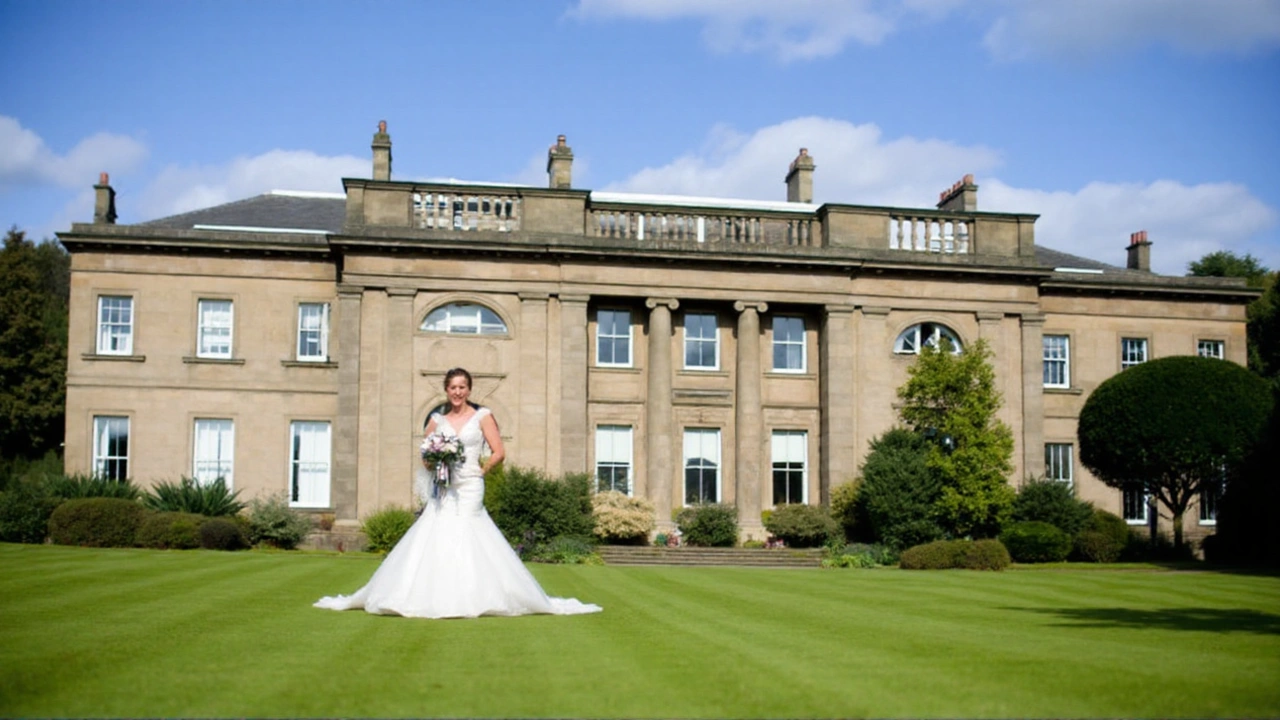Balbirnie House sets sights on growth with 12-lodge plan
Balbirnie House Hotel in Markinch, Fife has submitted plans to add 12 luxury lodges within its sprawling 400-acre parkland, a move aimed squarely at scaling up weddings and events without losing the country house character that draws guests in the first place.
The Georgian mansion, dating to 1815 with earlier roots in the late 18th century, is already one of Scotland’s best-known privately owned small luxury hotels. It operates with 4 AA Red Stars and has built its reputation on fine dining, careful service, and that classic Scottish mix of warmth and understatement. The lodge plan is a natural extension: more beds on site, more options for groups, and less overflow to off-site accommodation when a big wedding or corporate retreat lands.
The proposal places the lodges within the estate grounds rather than near the main house, allowing wedding parties and event delegates to have short, easy access to the ballroom, dining rooms, and gardens while still enjoying privacy. That layout also helps preserve the sightlines and heritage character of the main building, which was shaped by architect Richard Crichton and later adaptations. The wider estate includes listed structures, such as 18th-century stables now repurposed as craft workshops, and several lodge buildings by noted architects of the period.
Balbirnie has operated as a hotel since 1990, after the Glenrothes Development Corporation purchased the estate in 1969 and set the path for its modern use. Over time, it has leaned into weddings and major celebrations, supported by conference spaces, access to nearby golf, and the sheer breadth of the grounds. The lodge plan signals confidence that Scotland’s weddings-and-events market still has room to run, even as venues compete to keep pace with guest expectations on space, privacy, and convenience.
Weddings and corporate gatherings tend to bring complex logistics: rehearsal dinners, late-night returns, early starts for hair and makeup, storage for kit and flowers, transport for elderly guests. On-site lodges solve a lot of those pain points. They cut shuttle runs, keep groups together, and reduce late-night travel. For planners, that can be the difference between choosing a venue and moving on.
Fife Council will review the application under the usual planning process, which generally weighs heritage, landscape and biodiversity impacts, drainage, access, and traffic. With listed buildings on the estate and mature parkland to protect, the design and placement of the new units will be central to the decision. Expect conditions around materials, lighting, planting, and pathways, all designed to ensure the lodges fit the setting and don’t dilute the historic core.
It’s common for hospitality lodge projects to be delivered in phases. That lets a venue meet demand without major disruption, test occupancy patterns, and refine interiors for different types of stays—think family suites for weekend weddings in spring and summer, then quieter couples’ retreats through autumn and winter. Phasing also spreads construction traffic and reduces the impact on day-to-day hotel operations.
The push into lodge accommodation reflects how guests now use high-end country houses. Many couples want an entire weekend: arrival drinks on Friday, the ceremony and celebration on Saturday, relaxed brunch and activities on Sunday. Lodges add room for grandparents, children, wedding parties, and friends who want to linger, walk the grounds, or play a round of golf without leaving the estate.
From a business angle, this is about yield as much as volume. More on-site rooms mean more revenue per event and greater control of the guest experience from check-in to checkout. It also reduces the risk of losing bookings because a group can’t secure enough rooms nearby. For corporate groups, lodges are a draw when teams want breakout time, quiet space, and easy morning access to meeting rooms.
Local impact matters too. Projects like this usually mean construction work for regional contractors and a bump for local suppliers—florists, photographers, event decorators, car services, and entertainment. Once open, additional accommodation often translates into more permanent roles in housekeeping, food and beverage, maintenance, and events. In a county that markets itself on culture, golf, and coastlines, keeping visitors overnight is the economic engine.
The heritage context is a strength if handled well. The estate’s layered history—from the original late-1700s structure to Crichton’s 1815 redesign and the later stable conversions—gives planners a clear brief: new buildings should be modest in scale, carefully sited, and finished in sympathetic materials. Contemporary lodge design can work with that. Low-profile rooflines, toned-down exterior palettes, and screened landscaping help new units blend into parkland rather than compete with the main house.
Sustainability will likely sit near the top of the planning conversation. Across Scotland, lodge projects are leaning into low-energy heating, high-grade insulation, water-saving fixtures, EV charging, and careful lighting to protect wildlife corridors. Fife’s process often looks for measurable steps—better biodiversity through planting plans, tree protection, and Sustainable Drainage Systems that slow and clean runoff during heavy rain.
Balbirnie’s pitch also sits within a wider recovery story. Since the pandemic, Scotland’s hospitality sector has reopened with an emphasis on multi-day experiences and private buyouts. Venues that add flexible, self-contained accommodation tend to capture longer stays and more shoulder-season business. Country house hotels with room to expand are using lodges to bridge the gap between classic suites in the main building and the privacy modern travelers want.
The estate’s scale helps. Four hundred acres offer room for walking routes, photography spots, and quiet corners for couples or delegates to decompress. Done carefully, lodges can sit near wooded edges or gentle rises, giving guests views and seclusion without creating a sprawl. The promise to preserve the “intimate” feel isn’t just marketing—it’s a practical requirement when your main asset is atmosphere.
Traffic and access will be part of the scrutiny. Wedding peaks can be intense, with caterers, bands, and guests arriving within tight windows. Expect the plan to address drop-off points, discreet parking, and service routes that keep event logistics out of sight. Good wayfinding, subtle lighting, and managed paths reduce wear on lawns and keep the estate’s calm intact.
For couples, the message is simple: more rooms on site, less hassle, and a better chance of hosting everyone in one place. For corporate organizers, it’s about privacy, easy movement between accommodation and meeting spaces, and predictable schedules. For the hotel, it’s higher resilience to seasonal swings and a stronger hand when competing with larger resorts.
Balbirnie’s history underpins the bet. As a long-standing wedding destination with fine dining and established service teams, it already has the core demand. The new lodges aim to catch the demand it can’t currently house, keep wedding parties together, and attract multi-day events that need room to breathe.

What the expansion means for Fife and Scotland’s hospitality
In Fife, visitor economy growth comes from persuading people to stay the night rather than make day trips. More on-site accommodation helps spread spending across local businesses and extends visits even in cooler months when the landscape and heritage still pull visitors in. If approved, these lodges would work in that direction—steadying occupancy and encouraging packaged experiences around dining, golf access, and countryside walks.
The planning stage is where the real shape of the project emerges. Layout, distances from trees and water features, lighting plans for evening arrivals, and the exact mix of lodge sizes will all matter. Accessibility will be another focus—step-free entries, accessible bathrooms, and parking close to certain units are now expected as standard, not extras.
Competitive pressure is real. Scotland’s top venues are investing in spa upgrades, chef-led dining, and year-round event calendars. Lodges give Balbirnie a flexible tool that sits alongside its ballroom, gardens, and restaurants. They can be booked for families one weekend and repurposed for executive teams the next, with the main house serving as the gathering place.
The hotel’s team will also be mindful of guest experience beyond the big day. Thoughtful interiors, soundproofing, and smart room controls make a difference when a wedding runs late and children need sleep. Storage for dresses, suits, and equipment; small kitchenettes for early risers; and outdoor seating for morning coffee—these are practical touches that turn a good stay into a loyal one.
If the application secures consent, don’t expect dramatic change to the estate’s silhouette. The ambition is capacity, not reinvention. Balbirnie’s value is tied to a sense of place built over centuries. The lodge plan is a way to welcome more people into that story—without writing over the parts that make it special.
